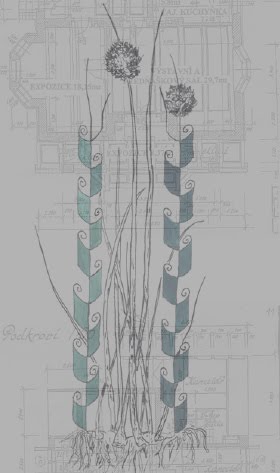January 19 – February 20, 2010, Trmalova vila, Vilova 11, Prague
The art project takes the form of a site-specific installation, reacting to the environment of the exhibition space, it’s historical and artistic context. Trmalova Villa is a family residence built by Jan Kotera, one of the key figures initiating Czech modern architecture around the turn of the 19th/20th century. The break away from the classical style had two sides. On one hand it meant an embracing of new artistic concepts (like cubism for example) and transferring them into architectural matter. On the other hand it meant embracing Czech folklore like the local, ‘original’ alternative to the international style of classicist architecture. The emphasis on floral and geometric ornaments was also typical for symbolism/art deco, drawing on the fascination with both ‘local’ and exotic cultures (as the oriental inspiration from Japanese woodcuts).
 Yet folklore as a form of art soon became an endangered species, threatened by modern industrial society – engineering and functionality took the lead soon. This is a fate which folklore shared with one of its frequent motives – flowers and plants. Marketa Kubacakova & Andran Abramjan drew a parallel between this two worlds, treating Trmalova Vila (today a protected cultural heritage site) as a natural reserve which is home to a rare species of ‘plants’. A walking path was set up and labels explaining the natural phenomena to which attention should be paid to – similar like you have on a hiking path in a natural reserve area – were put in place. The labels were directing attention to the rare plants of the local flora, which were present in the ornaments and interior architecture elements of the building.
Yet folklore as a form of art soon became an endangered species, threatened by modern industrial society – engineering and functionality took the lead soon. This is a fate which folklore shared with one of its frequent motives – flowers and plants. Marketa Kubacakova & Andran Abramjan drew a parallel between this two worlds, treating Trmalova Vila (today a protected cultural heritage site) as a natural reserve which is home to a rare species of ‘plants’. A walking path was set up and labels explaining the natural phenomena to which attention should be paid to – similar like you have on a hiking path in a natural reserve area – were put in place. The labels were directing attention to the rare plants of the local flora, which were present in the ornaments and interior architecture elements of the building.
When entering the house the visitors are basically entering a museum. But after wandering around for a while, they start to realize that there is a discrepancy, that there are actually two kinds of labels, two kinds of displays. One type of labels are the ‘museum labels’ attached to the actual displays. Another set of labels explains the ‘local flora’, giving advice how to spot the rare natural occurrences. In a corner of one of the rooms, there is a TV, which seems to be showing some documentary movie. Actually, it is a documentary movie about the ‘flora’ of Trmalova Vila. If some less attentive visitor did not get the idea of the artistic intervention until now, this is the last push, which should make it clear to everyone what is going on here. The tone of the video is kept serious and entertaining at the same time, as National Geographic videos are.
I like the idea of putting another layer to the ‘dead’ museum exhibit. The house itself, originally a functional element, was put into a ‘reserve’. It no longer serves it original function, it turned into a ‘ghost house’. Now Marketa Kubacakova & Andran Abramjan are bringing life back to it. The staircase becomes a waterfall, the wall decoration a rare night flower, the last of its kind. The intervention shows once again the know fact that all of our perception and thinking is contextual. It is the framing that decides what we see and how we understand out environment. In addition to that the artwork addresses the social dimension of ‘preserving’ our heritage, contemplating how society treats both culture and nature. It shows how close these two elements actually are related and that they are actually one in the way society approaches them.